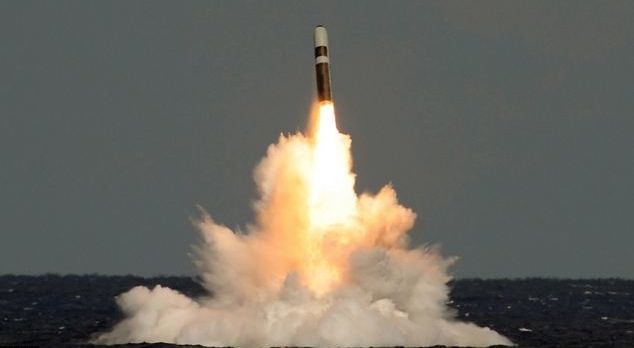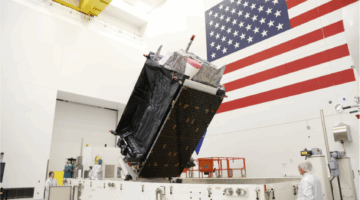
CAPITOL HILL: As the Air Force train pulls out of the station, the Navy’s running alongside asking to be pulled aboard. Both services will need to replace aging nuclear missiles sometime ca. 2030. They could save money by coordinating their modernization programs — but the Air Force is on a tighter schedule and the window of opportunity is starting to close.

“Commonality [is] a topic that I’ve been pretty aggressively shopping around town to anyone who will listen to me,” said Vice Adm. Terry Benedict, the Navy’s director of Strategic Systems Programs. But while the Navy’s not officially launched an effort to replace its Trident submarined-launched ballistic missile, the Air Force’s Minuteman ICBM replacement, the Ground-Based Strategic Deterrent, already issued a Request For Information back in January. “Because of the urgency of the GBSD effort,” Benedict said, “we need to begin this assessment now.”
“There’s absolute consensus at the leadership level to begin that work,” Benedict said at Peter Huessy breakfast hosted by the Air Force Association’s Mitchell Institute. “I think the direction to formally proceed on that work is imminent.”
In the Office of the Secretary of Defense, the Pentagon’s top buyer, Undersecretary Frank Kendall himself, is conducting a Strategic Posture Review that addresses the commonality question. Benedict has also spoken to the Air Force’s top buyer, Assistant Sec. Bill LaPlante, and to the service’s program executive officer for weapons, Maj. Gen. Scott Jansson. Strategic Command chief Adm. Cecil Haney even got Benedict to address a meeting of “basically every flag officer in the United States Air Force associated with ICBMs.”
“It’s hard to argue with [commonality]: I mean, who doesn’t want to save money?” Benedict said. “But, rightfully, they have a requirement that they have to meet to replace the Minuteman III, and so there are concerns that this does not distract them or derail them from meeting that requirement, and I respect that.”
The Air Force and the Navy also need their missiles to do different things. At the most basic level, launching from a silo underground is very different from launching from a submarine underwater. A component that works for both may not be optimal for either.
Reconciling those requirements will require extensive study: Where can the Air Force and the Navy do things the same way to save money without compromising eithers’ mission, and where do they still need distinct approaches? Then, once that difficult technical and tactical analysis is done, the often balky Pentagon acquisition processes actually has to do something with it.

To do this right, “you ensure that this is not just a Navy or an Air Force initiative,” Benedict said. “That’s the reason why STRATCOM has to be intimately involved with this as well as OSD [the Office of the Secretary Defense] and the Joint Staff… As we look at potential requirements impacts, then those who own those requirements are going need to [say whether] they can still meet their mission with a compromise in the requirement.”
There’s a wide range of options for just how intimately intertwined the Navy and Air Force programs need to be, Benedict said. At the low end would be “resource commonality,” such as the two services jointly buying rocket fuel constituents but then mixing them in different formulas for different engines. They could coordinate manufacturing, because even if they don’t buy the same parts, they’re buying them from the same small set of specialized companies. Or they could design their missiles to use some common components or even entire subassemblies.
At the far end is a single common missile procured for both services by a joint program office, though Benedict downplayed that possibility: “I’m not going there,” he said. “[That’s] the far end of the spectrum.” The admiral’s preferred examples of commonality were a little less dramatic.
“I would say that the common fuse effort that’s ongoing, that’s on schedule and on cost for a ’19 IOC [Initial Operating Capability], is a perfect example of how…the two services were able to sit down and work through these technical issues and find the acquisition strategy,” Benedict said. “We compromised requirements to get that out of design and into development and into production.”
That fuse is specifically for the Trident and the current Minuteman III. Benedict’s drive for greater commonality presumes the Minuteman replacement goes ahead, but that’s not guaranteed.
The Ground-Based Strategic Deterrent is under fire on grounds of both cost and necessity. Arms control advocates say a ground-based deterrent of any kind is no longer necessary. A RAND report — one the Air Force itself commissioned — recommended further extending the life of the Minuteman III rather than replacing it.
“Organizational inertia is going to push us back to the status quo, and in my opinion, that’s not going to be affordable in the long term,” said Benedict. Trying to extend the service life of the Navy’s Trident until 2084, when the planned Ohio Replacement Program sub goes out of service, would require an ever-more expensive series of expedients.
It would also allow the highly skilled and highly specialized industrial base to decay, he said, to the point where we couldn’t later change our minds and decide we wanted a new missile after all. “We simply do not produce enough ICBMs, SLBMs [submarine-launched ballistic missiles] to keep the industrial base viable with these long stretches in between [programs],” Benedict said. “With a reduced industrial capability…we place ourselves at risk.”

